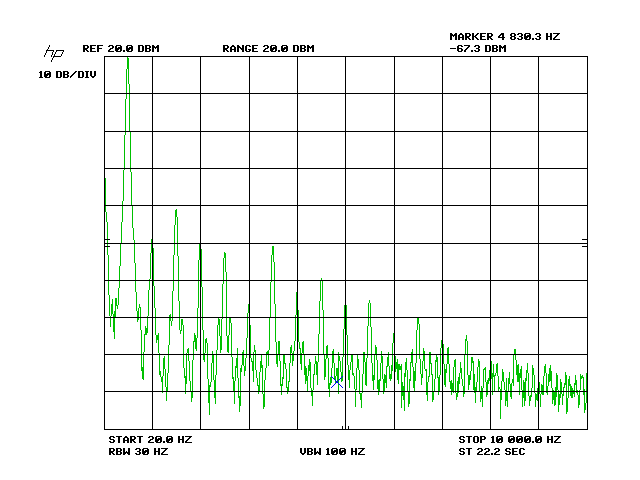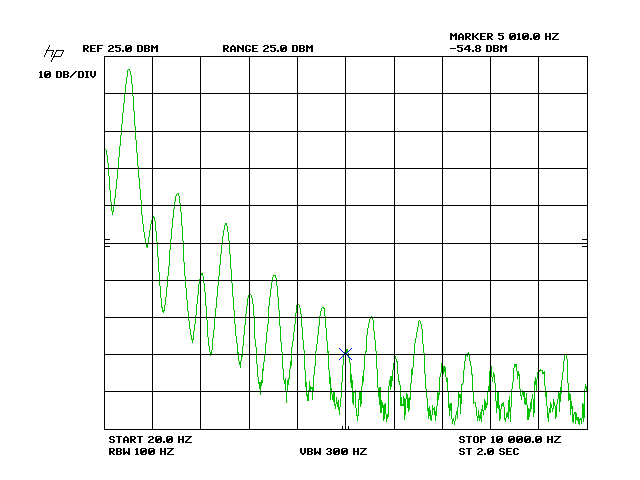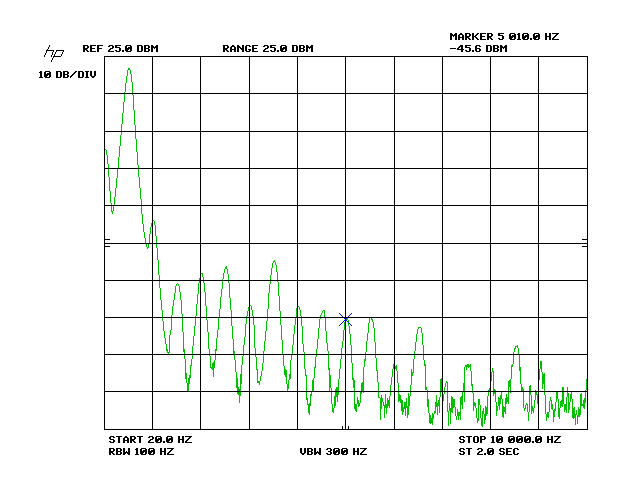| Getting the Tone You Want |
| My use of Spectrum Analyzers gives me a different perspective on the output of an amplifier than one would normally get looking at an oscilloscope. Because of the Logrithmic amplitude capability of the Spectrum Analyzer, it makes seeing all of the harmonic distortion an easy thing to do. Oscilloscopes show voltage with respect to time. But Spectrum Analyzers show voltage with respect to FREQUENCY. In this dimension, all of the energy output of an amplifier, across the audio spectrum and beyond, is visible. Now we can see the "personality" of an amplifier, that which determines it's tonality, whether harsh or melodic, clean or grungy. |
|
| Figure 1: Harmonic Output Spectrum This spectral plot shows the total energy output of an amplifier under test. For clarity, I chose to measure the range from 20Hz to 10,000Hz, as that's where most of the important harmonic information is. The tallest spike to the left is the fundamental. That is the signal we are feeding to the amplifier, in this case, a 500Hz sine wave. The next spike to it's right is the second harmonic and the next one to the right of that is the third harmonic, and so on. Push-pull vacuum tube amplifiers will tend to have low amounts of second harmonic, due to the nature of the circuit cancelling even-order harmonics. That's why many audiophiles prefer the sound of Single Ended Triode, or SET amplifiers. Triodes have copious amounts of even order harmonics, which, to many listeners, adds 'warmth' to the sound. Odd-order harmonics, since they are not even multiples of the input signal, sound atonal and harsh. As you can see in this amplifier's spectral plot, the sound quality tends toward harsh. |
|
| Figure 2: Even and Odd Harmonics Here is an amplifier whose spectral plot was recorded before I did any adjusting. The bias was at -13 volts on a pair of 6V6 output tubes. Not the third harmonic, fifth and seventh are larger than the second harmonic in amplitude This amplifier produced a somewhat unpleasant tone when it first arrived. |
|
| Figure 3: Tuning Out Odd Harmonics Here's what the amplifier looks like after re-biasing the output tubes while observing its spectral output. The ugliest of the odd harmonics was reduced by a whopping 23 dB! Amplifier power output increased slightly and the tubes run cooler, which has the additional benefit of increased tube longevity. The magic number for this amplifier was -19 volts of bias. This amp sounds better and its tubes will last longer. How's that for a synergistic gain? This is what we mean by "getting the tone"--your amplifier can sound differently depending on how it's biased. There are other things I can do to enhance or diminish certain tonal qualities, but I wanted to illustrate what a simple thing like bias adjustment can do to the sound of your amp. |
| Back to Amp Repair |








